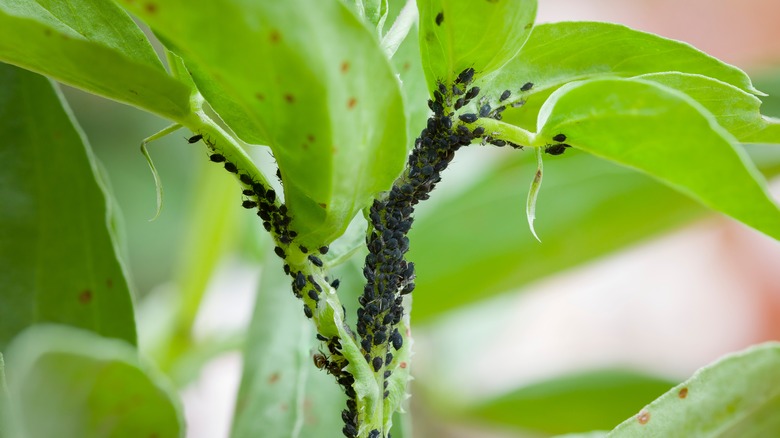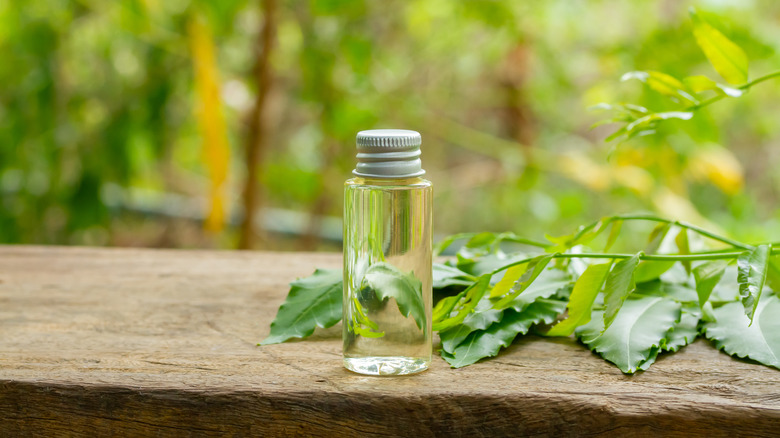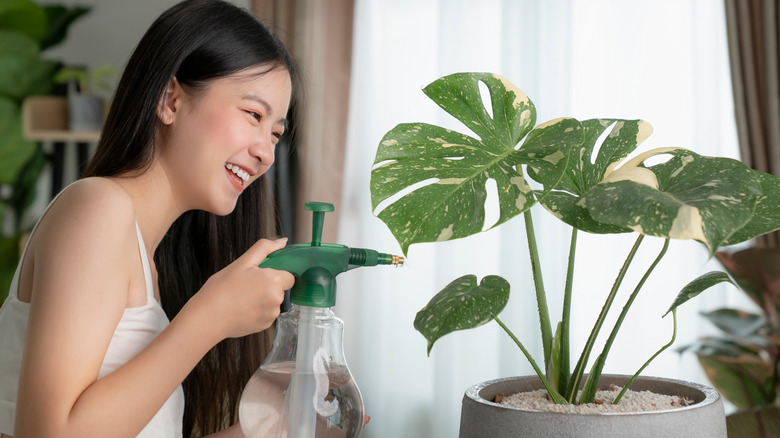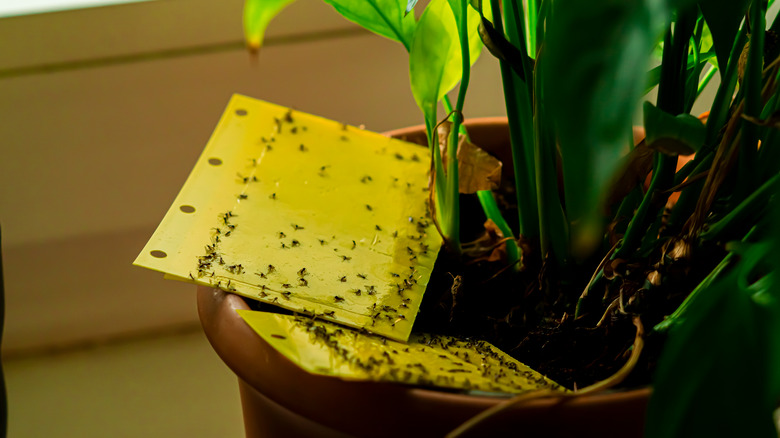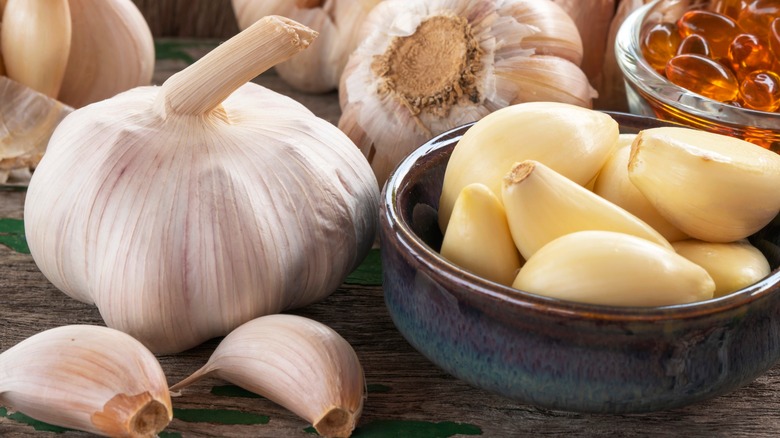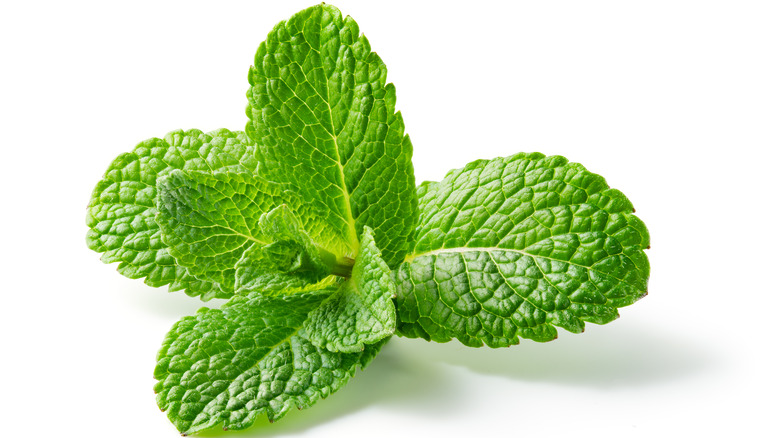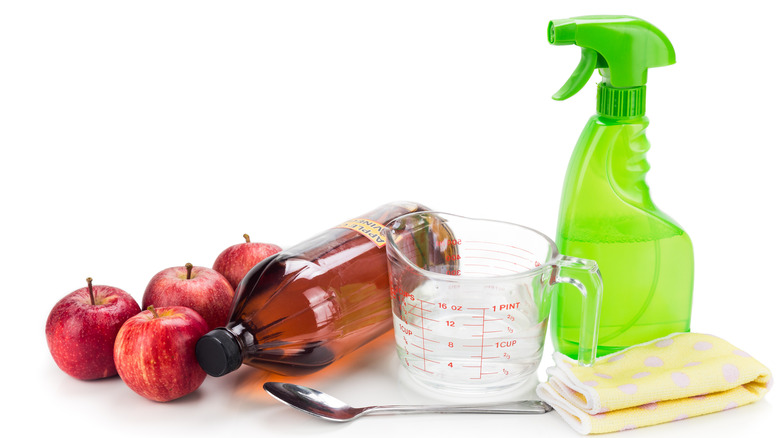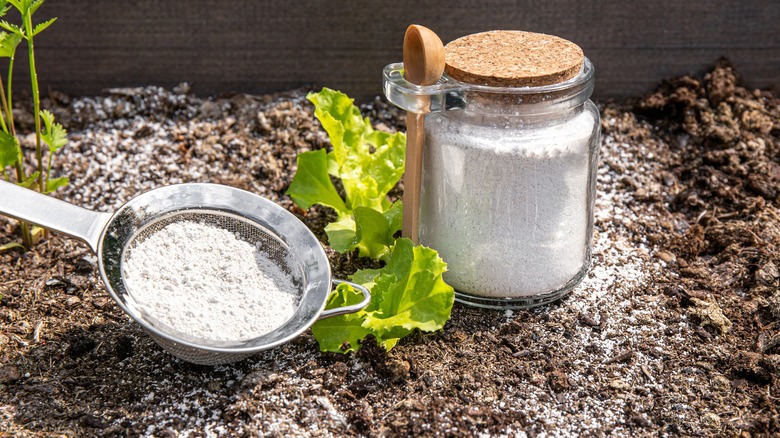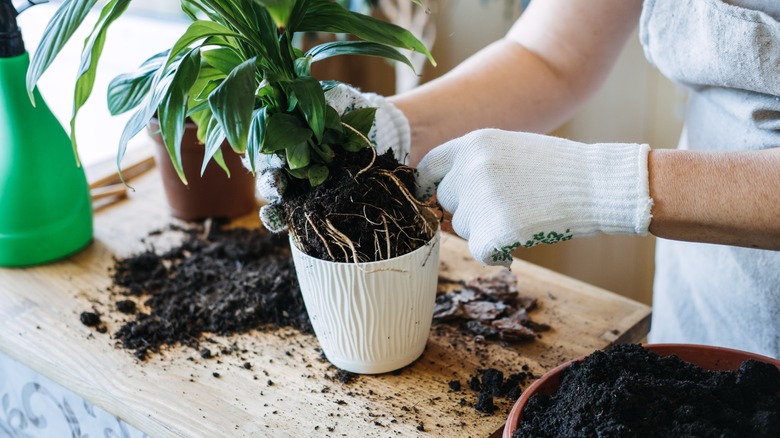How To Get Rid Of Bugs On Indoor Plants
Spotting a bug infestation on your indoor plants can be worrisome. Not only are the pests annoying and unsightly, but if they are left untreated, they can wreak havoc on your houseplants. Savvy Gardening points out that the inside of a home has a warmer and more controlled temperature than the outdoors. Additionally, there are few if any beneficial insects inside a home to help control the pest population, as they do outside. Together, these two pieces of information add up to a daunting reality: Homeowners who start with just a few pesky insects on their indoor plants may find themselves facing a huge infestation after just a short period of time.
When you're trying to get rid of bugs in indoor plants, avoid using harmful pesticides. Chemicals found in pesticides can be toxic to humans and pets. According to the EPA, pesticide use in the home can have an adverse effect on indoor air quality. Individuals exposed to pesticides may experience headaches, nausea, dizziness, eye, nose, or throat irritation, damage to their kidneys or central nervous systems, or an increased risk of cancer. Rather than relying on toxic pesticides to get rid of the pests on your indoor plants, try one of the safer methods outlined below.
Stock up on neem oil
Neem oil is a natural insecticide used to fight both indoor and outdoor pest infestations. The oil — which is derived from the leaves and seeds of the Azadirachta indica tree from South Asia — helps to control various species of bugs and insects. A few of these pests include moths, spider mites, aphids, and whiteflies. According to Platt Hill Nursery, one of the interesting things about neem oil is that different species of bugs have unique reactions to azadirachtin, the oil's active element. With smaller pests like aphids, for example, the thick substances will coat the bug's body and cause suffocation and immediate death.
While neem oil doesn't offer this instant extermination for large species, it is still an incredibly valuable asset for home gardeners. When other bugs are exposed to neem oil, it can suppress their hormones and desire to feed, or it may interfere with their reproductive cycles. Over time, this can cause the pests to starve to death and prevent them from reproducing and multiplying all over your plants.
To use neem oil to treat indoor plants' pest problems, spray the liquid directly on the leaves. Mornings and evenings are the best time of the day to spray the leaves, especially for plants in direct sunlight. Otherwise, the hot sun combined with the oil may leave burn marks on the leaves. In addition to working as a natural insecticide, neem oil can also prevent mildew and fungus from growing on a plant.
Use soap and water
Believe it or not, the same two ingredients you use to clean your dishes can also help fend off a pest infestation on your indoor plants. According to P. Allen Smith, mixing gentle dish soap with water and spraying it on the insects or bugs will break down the protective skin that covers the insect. When this protective skin — called the cuticle — breaks down, the bug will die. In order for dish soap to be effective, it will need to come into direct contact with the insects. So, when possible, spray it directly on the pests that you can see along with the plant's leaves.
A word of caution before you start mixing soapy water and using it to spray your plants. Just as dish soap can break down a bug's cuticle, it may also break down a plant's cuticle. You can test the soapy water solution to confirm whether it is safe for the specific plants in your home by spraying it on a few leaves. Then, wait a full day and assess to see where you notice any damage to the leaves. If there are any signs of damage, choose a different method.
Another important tip for using this method to clear up an infestation is to avoid any dish soaps formulated with antibacterial agents or degreasers. Doing so will help limit the chances of your plants having an adverse reaction to the soapy mixture.
Invest in sticky traps
Finding a natural insecticide that will target the pests on your plants is important. However, it can also be beneficial to trap bugs as they move between or around your houseplants. Sticky traps can help you do just that. Sticky traps use glue to catch bugs that pass over them. Pest Pointers shares that placing sticky traps strategically around your indoor plants can help you prevent pests from moving from an infested plant to a healthy plant. If you've recently cleared up an infestation, placing sticky traps around the plant can prevent a re-infestation.
Even if you're not dealing with an active or recent infestation, laying out a few sticky traps may still be a good idea. They can alert you to the presence of insects on or around your houseplants before you see any visible evidence of them or the damage they are causing. This early detection will enable you to move quickly to clear up the infestation and prevent the bugs from multiplying, which can greatly increase the chance of your plant remaining healthy.
Sticky traps come in various colors, with blue and yellow being the most common. According to the Texas A&M AgriLife Extension Service, many insects are attracted to the color yellow, making yellow sticky traps the best choice to protect your indoor plants.
Make your own garlic spray
Garlic has a very powerful scent. As the Toronto Garlic Festival reminds us, garlic has even been rumored to ward off vampires. While there isn't evidence to suggest that garlic will actually help deter vampires, or that vampires are real, it can work as an effective pest deterrent. Many insects do not like its strong scent and want to stay away from plants that smell like garlic.
Dre Campbell Farm explains how you can make a garlic spray for your indoor plants. This is an easy and effective method to control various insects, including aphids, whiteflies, spider mites, cabbage worms, mosquitoes, and more. Just add 2 cups of water, 5 garlic cloves, and 2 to 3 drops of gentle dish soap to a blend. Blend the mixture until smooth, strain it, and add the liquid to a spray bottle.
It is best to use the garlic spray immediately after preparing it. It will be the most potent (and the most effective at deterring bugs) when it is fresh. Spray the solution over the entire surface of each plant. Reapply the spray every one to two weeks, or more frequently following heavy watering. As is the case with most other treatment options, it is advised to test the garlic spray on a few leaves to assess each plant's reaction to it. Additionally, you should wear gloves and eye coverings when applying the solution. While made using natural ingredients, the mixture is highly concentrated and could cause a reaction if it gets on your skin or eyes.
Plant bug-repellent herbs
Some herbs naturally repel insects. Adding these plants to your indoor garden can help control your pest problem while providing fresh herbs for delicious home-cooked meals. According to Earth's Ally, many insects don't like the smell of some more fragrant herbs, including basil, mint, sage, lemongrass, and garlic. Each herb is most effective for specific species, so you'll want to do a little research to identify which pests are crawling all over your plants before deciding which herb to plant. For example, peppermint and spearmint can effectively ward off spiders, fleas, and flies, while sage is most effective against moths.
Farmers' Almanac shares a few flowers and plants that you can also add to your indoor garden to help keep pests away. If you're dealing with an aphid infestation, plant a few alliums or petunias around your houseplants. Chrysanthemums can be a welcome addition to your indoor garden if you're trying to keep spider mites from damaging your plants.
Utilize apple cider vinegar
Apple cider vinegar is often recommended for everything from cleaning to helping individuals stay healthy. Another benefit of this liquid is that it can help repel a variety of pests, including ants, flies, snails, and slugs. Angi shares how easy it is to mix up a basic apple cider or white vinegar solution and use it to treat your plants. Combine apple cider vinegar and water in a 1:3 ratio. Then, add 2 or 3 drops of mild liquid dish soap to the mixture. Pour the solution into a spray bottle.
If you're dealing with a heavy pest infestation, you can spray the solution directly onto the plant's leaves. Otherwise, spray a little along the base of each affected plant. When working with apple cider vinegar, always test the solution before spraying it over an entire plant. You should also never use apple cider vinegar spray during the day's heat for plants in direct sunlight, as it could cause them to burn. Reapply the spray about once a week.
Farmers' Almanac shares an additional way that apple cider vinegar can help with pest control. You can use it to make a trap for fungus gnats by filling a shallow bowl with a 1:1 ratio of apple cider vinegar and water and a few drops of liquid dish soap. Leave the traps near each affected plant or on top of the soil. Dump out and replace the mixture approximately every other day.
Pour diatomaceous earth
Diatomaceous earth, or DE as it is often called, is another option to consider when you're trying to rid your indoor plants of bugs. Farmers' Almanac explains that diatomaceous earth can puncture the protective layer of a bug's exoskeleton. After a short amount of time, this will dehydrate the bug and cause it to die. The reason diatomaceous earth is so effective is that it is made up of fossilized remains. The fossilized diatoms — a type of phytoplankton — have microscopic edges that generally don't irritate human skin, but are sharp enough to cut through a bug's hard outer shell.
Sprinkling diatomaceous earth along the base of a plant can be an effective strategy to get rid of bugs. You can even spread it between an infested plant and others in your indoor garden to keep bugs from traveling to the healthy plants. As Mantis Pest Solutions shares, you can also use diatomaceous earth to eliminate bugs lurking in a freshly cut Christmas tree. Just sprinkle the fossilized substance along the tree's base or over the leaves. If you prefer, let the tree sit in the garage for a few days with the diatomaceous earth sprinkled over it.
Take care when working with the powder, though. While it is generally safe to use in homes, it may cause irritation for individuals with asthma or other respiratory issues. If you plan to apply large quantities of diatomaceous earth, wearing a mask is a good idea.
Prevent future bug infestations
Knowing how to clear up a bug infestation on your indoor plants is important. However, there are also measures you can take to help prevent future infestations, as Maggie's Farm highlights. Whenever you bring any plants into your home, always check them for any signs of pests. You'll want to look over the entire plant (especially under the leaves) to ensure that you don't see any live bugs. Even if you think the plant is clear, it is still recommended to keep it away from the other plants in your home for a few weeks.
Another helpful tip is to be selective about which soil you use while potting your plants. Dirt from your yard may be wonderful for your outdoor garden, but you won't want to use it for indoor plants. The odds are good that there are several bugs in the soil, which can lead to a rapid infestation on all of the plants in your home, not just the one planted in the outdoor soil. Instead, choose fresh and uncontaminated soil and use it with a clean pot.
Sealing any potential points of entry into your home can also help prevent future pest infestations. If pests have no way to enter your home, they won't be able to threaten your houseplants. Inspect your windows and doors, fix any tears in the screens, replace missing or damaged weather stripping, and fill in holes in the walls or bricks. Finally, keep your plants healthy with the appropriate amounts of water and sunlight they need. A healthy plant is less likely to suffer from a major bug infestation than an unhealthy one.
